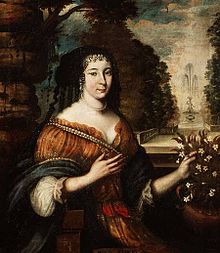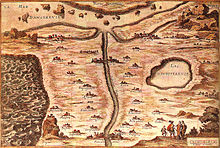Madeleine de Scudéry
Madeleine de Scudéry , called Mademoiselle de Scudéry (* 15. October 1607 in Le Havre ; † 2. June 1701 in Paris ) was a French writer of the baroque . She is one of the most important French authors of the 17th century and was the first French woman to be widely read outside of France.
Life and work
Mademoiselle de Scudéry, as she is usually called in literary histories, was born as the daughter of a petty aristocratic privateer captain and later commander of the fortified port of Le Havre . After she was orphaned at an early age, an uncle in Rouen took her and her six-year-old brother Georges into his home and gave them a good education.
After Georges had ended seven years as an officer in 1630 and had gone to Paris with the intention of becoming a man of letters, she followed him there and, since she did not intend to marry or did not have the necessary dowry, led one for the next 20 years common household with him.
She started writing through Georges, initially as his junior partner: together, albeit with a decreasing number of his part, who was mainly active as a dramatist, they wrote the novel Ibrahim, ou l'Illustre Bassa (4 vols., 1641). Through Georges she also gained access to the Parisian salon culture and her central personality, the Marquise de Rambouillet . Later she was part of the circle of the great patron of the 1650s, Finance Minister Nicolas Fouquet .
Madeleine de Scudéry's literary breakthrough - albeit still under the name of her brother - were the pseudo-historical novels Artamène ou le Grand Cyrus (1649–53) and Clélie, histoire romaine (1654–60), which today are the highlights of the baroque heroic-gallant novel apply and made her the prototypical author of the so-called Preziosität : a way of life and speech practiced predominantly by noble women, but also by some gentlemen and petty aristocratic as well as bourgeois intellectuals, of extreme, often exaggerated sophistication. Both novels are ten-volume works with a loosely structured main storyline and many insertions, with three central issues: the heroic-virtuous love of high-ranking women defying all strokes of fate, war and heroic deeds of the gentlemen who love them, and witty and gallant conversations between men and women on the subject of love. The Carte de Tendre from Clélie has become proverbial , an allegorical map of the realm of love, where passion is tamed and transformed into a sympathy of souls.
Le Grand Cyrus and Clélie were read mainly by aristocratic audiences across Europe, but also among the bourgeoisie. For the Parisian readers they were alsoof interestas romanesque romances: many of the events depicted and a large number of the characters who appeared had recognizable models in contemporary France. The figure of the protagonist Cyrus bore the traits of the great general Prince de Condé , other figures resembled writers from the author's environment, such as Madame de Sévigné or Paul Pellisson , with whom she had a closer, but undoubtedly platonic friendship.
After de Scudéry had worked her way out of the shadow of her brother and he was banished from Paris to Normandy after the end of the " Fronde " (1652) , she created her own salon with the Samedis ("Saturday receptions "). Here she was swarmed around as the “new Sappho ”, welcomed almost all the important authors of the time, as well as members of the better society and, to a more modest extent, succeeded the Marquise de Rambouillet , whose program it had been after 150 years To educate war-brutal aristocratic men to be elected chivalrous, discreetly flirtatious and, if necessary, lyrically amateurish gentlemen.
The other novels that de Scudéry, now under his own name, wrote (e.g. 1661 Célinte or 1667 Histoire de Mathilde d'Aguilar ), following the new fashion, were significantly shorter and more realistic, but less successful. Around 1670 she was a candidate for a seat in the Académie française . But then she only received the first “eloquence award” awarded by the Académie ( prix d'éloquence , 1671).
By 1670 at the latest, she lost her status as a novelist. Already in 1666 a generation younger had Boileau the Grand Cyrus and Clélie (but he presupposed known as the) in his satirical Dialogue des héros de roman ridiculed. Her multi-volume Conversations morales (1680–92) brought Mlle de Scudéry yet again new fame.
She reached the very old age of 93 (by the standards of the time).
Madeleine de Scudéry is the protagonist of ETA Hoffmann's detective novel Das Fräulein von Scuderi (1819/21).
Works (selection)
- Ibrahim ou l'illustre Bassa (4 vols., 1641)
- Artamène ou le Grand Cyrus (10 vols., 1649–53)
- Clélie, histoire romaine (Clelia) (10 vols., 1654–60)
- Célinte (1661)
- Histoire de Mathilde d'Aguilar (1667)
- Conversations morales (1680 ff.)
literature
- Alain Niderst: Madeleine de Scudéry, Paul Pellisson et leur monde. Presses universitaires de France, Paris 1976 ( Publications de l'Université de Rouen 36 Série littéraire , ISSN 1292-1211 ).
- René Godenne: Les romans de Mademoiselle de Scudéry. Droz, Geneva 1983 ( Publications romanes et françaises 164, ISSN 0079-7812 ).
- Erich Köhler: Lectures on the history of French literature. Volume: Pre-Classical. Kohlhammer, Stuttgart et al. 1983, ISBN 3-17-007693-0 , pp. 42-46.
- Nicole Aronson: Mademoiselle de Scudéry. Ou le voyage au pays de Tendre. Fayard, Paris 1986, ISBN 2-213-01743-3 .
- Renate Baader : Dames de lettres. Author of the precious, highly aristocratic and “modern” salon (1649–1698). Mlle de Scudéry, Mlle de Montpensier , Mme d'Aulnoy . Metzler, Stuttgart 1986, ISBN 3-476-00609-3 ( Romance essays 5), (Also: Saarbrücken University , Habil.-Schr., 1984)
- Rosemarie Schuder : The Queen's Pictures, Rütten & Loening, Berlin 1990, ISBN 3-352-00369-6 .
- Alain Niderst (ed.): Les trois Scudéry. Actes du colloque du Havre 1-5 October 1991. Klincksieck, Paris 1993, ISBN 2-252-02840-8 ( Actes et Colloques 34)
- Renate Kroll: Femme poète. Madeleine de Scudéry and the “poésie précieuse”. Niemeyer, Tübingen 1996, ISBN 3-484-55023-6 ( Mimesis 23)
- Delphine Denis: La muse galante. Poétique de la conversation dans l'œuvre de Madeleine de Scudéry. Champion ua, Paris ua 1997, ISBN 2-85203-568-5 ( Lumière Classique 12)
- Gerhard Penzkofer: "L'art de mensonge". Telling as a baroque art of lies in the novels of Mademoiselle de Scudéry. Narr, Tübingen 1998, ISBN 3-8233-4796-9 ( Romanica Monacensia 56), (also: Munich, Univ., Habil.-Schr.)
- Nathalie Grande: Stratégies de romancières. De Clélie à La Princesse de Clèves. (1654-1678). Champion, Paris 1999, ISBN 2-7453-0015-6 ( Lumière classique 20)
- Delphine Denis, Anne-Élisabeth Spica (ed.): Madeleine de Scudéry. Une femme de lettres au XVIIe siècle. Actes du Colloque international de Paris (June 28-30, 2001). Artois Presses Université, Arras 2002, ISBN 2-910663-84-1 ( Etudes littéraires ).
- Anne-Élisabeth Spica: Savoir peindre en littérature. The description of the roman on the 17th siècle. Georges and Madeleine de Scudéry. Champion ua, Paris 2002, ISBN 2-7453-0652-9 ( Lumière classique 45)
- Katharina Krause: How do you describe architecture? The Miss von Scudéry is walking through Versailles. Rombach, Freiburg im Breisgau 2002, ISBN 3-7930-9322-0
- Jörn Steigerwald: L'Oiconomie des plaisirs. La praxéologie de l'amour gallant. Speaking of the "Clélie". In: Journal of French Language and Literature. 118, 3, 2008, ISSN 0044-2747 , pp. 237-257
- Jörn Steigerwald: On the (im) possibility of social practice in the theater state of Louis XIV. Madeleine de Scudéry's dialogic staging of festival descriptions. In: Kirsten Dickhaut, Jörn Steigerwald, Birgit Wagner (eds.): Social and aesthetic practice of courtly festival culture in the 16th and 17th centuries. Harrassowitz, Wiesbaden 2009, ISBN 978-3-447-05919-0 , pp. 215-233 ( Culturæ 1)
- Oliver Mallick: "Le heros de toutes les seasons": praise for the rulers and political reflections in Madeleine de Scudéry's novel "La Promenade de Versailles" (1669) . In: Journal for Historical Research . 41, 4, 2014, ISSN 0340-0174 , pp. 619-686.
Web links
- Literature by and about Madeleine de Scudéry in the catalog of the German National Library
- Works by and about Madeleine de Scudéry in the German Digital Library
- John Conley: Entry in Edward N. Zalta (Ed.): Stanford Encyclopedia of Philosophy .
- The complete novel Artamène ou le Grand Cyrus in French. - revised and structured
- Current directory of Scudéry's works in VD 17
- Article in name, title and dates of the French Literature (main source for the section "Life and Creation")
- Madeleine de Scudéry. In: FemBio. Women's biography research (with references and citations).
supporting documents
- ↑ A slightly larger version (there is a contemporary explanation along with a cupid figure on the right edge) as well as an explanation of the allegorical paths on the map and their place in life with Jean Firges : Molière: "The misanthropist. Plea against a lying society." Exemplary series literature and philosophy, 15. Sonnenberg, Annweiler 2004 ISBN 3-933264-31-6 p. 114f.
| personal data | |
|---|---|
| SURNAME | Scudéry, Madeleine de |
| SHORT DESCRIPTION | French writer |
| DATE OF BIRTH | October 15, 1607 |
| PLACE OF BIRTH | Le Havre |
| DATE OF DEATH | June 2, 1701 |
| PLACE OF DEATH | Paris |

